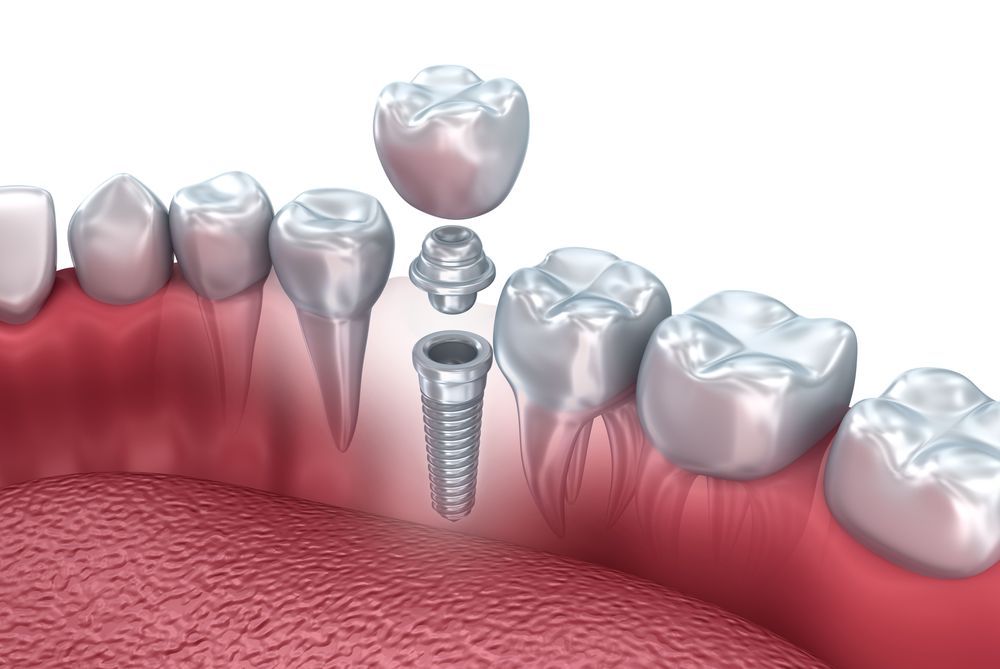Implant-Supported Crowns
Tooth loss can take a serious toll on your quality of life, making it difficult to smile confidently, eat properly, and speak clearly. If you have a single missing tooth, an implant-supported crown can restore the integrity of your smile. Implant-supported crowns are affixed to dental implants, which provide unrivaled support and stability. These restorations not only look and feel natural, but they also encourage jawbone regeneration at the site of a missing tooth.
The Structure of an Implant-Supported Crown

An implant-supported crown is affixed to dental implants, which are secured directly in the jawbone.
Implant-Supported Crowns vs. Traditional Dental Bridges
A traditional dental bridge is comprised of one or more artificial teeth (pontics) nestled between two dental crowns. This restoration is designed to bridge the gap created by tooth loss and restore complete function and aesthetics. Adjacent healthy teeth serve to support the bridge, however, they must be reshaped to accommodate the restoration. As a traditional dental bridge rests atop the gums, it does not prevent further jawbone degeneration, which commonly occurs after tooth loss.
Implant-supported crowns not only look and feel natural, but they also encourage jawbone regeneration at the site of a missing tooth.
An implant-supported crown replaces an entire tooth from root to crown. This restoration is supported by a dental implant, which is surgically embedded in the jawbone. Dental implants provide a strong, solid foundation for a customized crown. In addition, they act as artificial tooth roots, stimulating the jawbone each time you bite down. This process helps to counteract bone degeneration and promote jawbone regrowth. While dental crowns will need to be replaced in the future, dental implants are designed to provide a lifetime of support.
Are You a Candidate?
You may be a candidate for an implant-supported crown if you:
- Experience isolated tooth loss
- Are in good oral health and free from periodontal disease
- Are looking for a permanent tooth replacement solution
- Do not smoke
- Have a strong and stable jawbone
As implants are inserted directly into the jawbone, they require sufficient jawbone density for support. If you have sustained jawbone degeneration, you may require a preliminary bone graft or sinus lift to restore your candidacy for treatment. While these procedures can extend your treatment timeline by six to nine months, they are integral to the success of dental implants.
The Initial Consultation
During the initial consultation, your dentist may request x-rays or other advanced images to evaluate your smile and determine your candidacy. If you require any prerequisite procedures, your dentist can review the treatment process and timeline, as well as answer any questions you may have.
The Implant-Supported Crown Procedure
If you are ready to proceed with dental implant surgery, your dentist will begin by numbing your gums with local anesthesia. You may also discuss stronger sedation options with your dentist if you feel especially nervous about undergoing treatment. Once you are comfortable, your dentist can make a small incision in your gums, through which implants will be placed. Your dentist can then close the incision with sutures.
Over the next three to six months, the dental implants will fuse with your jawbone in a process known as osseointegration. After recovery, you can return to the office to receive the abutments, which will connect the implant to the crown. Impressions will then be taken of your smile and used to fabricate your custom crown. Once your restoration is ready, your dentist can check it against your bite to ensure the crown does not disrupt your occlusion. If no modifications are necessary, the crown will be secured, and you can leave feeling confident in your smile.
Factors Affecting the Cost of Implant-Supported Crowns
The cost of implant-supported crowns varies from patient to patient and depends on a variety of factors, including:
- Dentist’s experience: A more experienced dentist typically charges more than a dentist new to the industry. However, a highly qualified dentist can often reduce your risk of complications and the need to undergo costly retreatment.
- Number of implants: If you have intermittent tooth loss, you may require more than one implant. The more implants you receive, the higher the cost of treatment. A single implant costs between $1,600 and $2,200.
- Preliminary procedures: If you require bone grafting, sinus lift surgery, or periodontal disease treatment prior to implant surgery, you can expect more expenses.
- Restoration materials: Dental crowns can be fashioned from several materials, including porcelain, porcelain-fused-to-metal, and zirconia. The higher the grade, the more expensive the restoration. While zirconia is typically the most costly, it is also the most durable. Each crown can range from $500 to $2,500.
Dental implants are not always covered by insurance, however, many dental practices offer in-office payment plans or accept third party financing to help cover out-of-pocket costs. While implant-supported crowns are more expensive than other restorative solutions, they are a long-term investment in the health of your smile.
